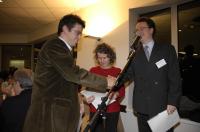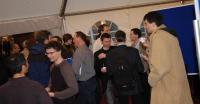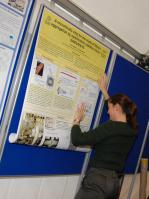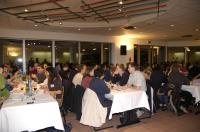- Home
- News
- General News
- The Users' Meeting...
The Users' Meeting breaks records
13-02-2007
Intense activity took place last week in the ESRF auditorium and meeting rooms. A total of three workshops, combined with the ESRF Users’ Meeting, attracted 350 scientists from 22 different countries worldwide, the highest number in recent years. This unprecedented record presented the perfect scenario to discuss the Upgrade Programme of the facility, as well as new trends in different scientific fields.
Share
The Users’ Meeting 2007 was focused, to a great extent, on the Upgrade Programme, designed to keep the ESRF at the top of the scientific and technical scale for the next decade. “We want to continue producing high impact science for a modest cost”, explains Ed Mitchell. Carsten Detlefs presented some of the key scientific cases that will be possible if the upgrade is approved. For example, research at a nanometre scale will make it possible to study cellular structures and create elemental maps at unprecedented resolution, help the development of even smaller semiconductors or more efficient devices for data recording and also to study the fundamental properties of materials. Optimised detection schemes, automation and synergies between beamlines might increase the throughput, making possible experiments that are rejected today due to scheduling limitations. Extreme sample environments, such as high pressure and high magnetic fields could give experimental access to new fields in planetary and geosciences, and in quantum phase transitions of strongly correlated electron systems. The upgrade also intends to increase the capacity for emerging fields that make heavy use of imaging techniques, such as environmental sciences, clinical applications, paleontology and cultural history.
The team also described the main changes that the ring and beamlines would experience. A series of new long beamlines to cater to nano-focusing applications are projected, together with an extension of the experimental hall, to include additional lab and office space. Beamlines with two end stations could become independent from each other, which could eventually lead to an increase in the overall number of beamlines. The extension construction and refurbishment in the machine will mean some extended shutdown time over several years’ but the results will be worth it.
|
|
|
|
|
|
Four moments of the Users' Meeting. Left: Pietro Gambardella receives his Young Scientist Award from Laszlo Vincze, head of the Users' Organisation. Middle: coffee break. Right: Anne Martel hangs up her poster, for which she was later awarded. Far right: The traditional Users' Meeting dinner. |
The Users’ meeting wasn’t only about the upgrade, though. A plenary talk by Prof. Peter Müller-Buschbaum, from the T.U. München, opened the meeting. Müller-Buschbaum focused on the study of local structures with micro and nanobeams, showing results of measurements carried out at ID13.
The traditional Young Scientist Award, given annually to a researcher under 35 for work at the ESRF, was awarded to Pietro Gambardella, a scientist at the Institut Català de Nanotecnologia, in Barcelona (Spain) and user of ID08. The prize acknowledges his work on “the understanding of magnetic properties of low-dimensional systems using polarised X-ray Absorption Spectroscopy”.
Poster record
Another record broken this year was the number of posters exhibited in a specially set-up marquee. A total of 102 posters filled the space with outstanding science cases. The prize for the best poster was awarded to Anne Martel, a PhD student on ID13. Her poster presented a microfluidic chip for the study of fibroin aggregation using the techniques of micro-SAXS/WAXS at the ESRF.
Top image: The ESRF auditorium during the Users' Meeting.







